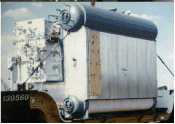| How
does Ambient Temperature & Elevation affect Boiler Fan Capacity? |
 |

The
amount of air in mass units (lb/h or kg/h) required to generate a given
amount of steam in a boiler is unaffected by ambient conditions or
density of air as it depends only on the amount of fuel fired in Million
Btu/h(HHV),excess air and fuel heating value.This can be seen from the Million
Btu method of combustion calculations .Assuming that the boiler efficiency
does not change much with ambient conditions,the air mass flow and flue
gas mass flow will be approximately the same at different ambient conditions.
However when ambient temperature and elevation change the density of air
changes,which affects the volume of air flow and the head
the fan can deliver and thus it affects the fan performance.Hence it is
important for boiler engineers to be aware of the density factor,while
sizing fans for boilers.
The
mass flow of air is given by the expression:
W=60rq
where
W=air flow in lb/h,q=volumetric flow in acfm and r
is the density of air inlb/ft3
The density
r
decreases
with altitude as shown in the following table.
Effect of altitude on air density
| altitude,ft |
density factor |
| 0 |
1 |
| 1000 |
0.964 |
| 2000 |
0.930 |
| 3000 |
0.896 |
| 4000 |
0.864 |
| 5000 |
0.832 |
| 6000 |
0.801 |
| 7000 |
0.772 |
| 8000 |
0.743 |
Also,the fan
head H is usually expressed in in wc and the impact of density on
fan head is as follows:
H/r
=constant
Hence
if a fan develops 18000 acfm at 18 in wc at 1000 ft and 60 F and we would
like to know what head it develops at 4000 ft.The air density at 1000 ft
= 0.075x.964=0.0723 lb/ft3 and at 4000 ft,it is 0.075x0.864=0.0648
lb/ft3
where
the factors 0.864 and 0.964 are from table above.Using the above equation
H/r=constant,we have:
18/0.964
=H/0.864 or H=16.1 in wc,which may or may not be adequete for proper boiler
operation.
The
mass flow of air at 1000 ft =18000x0.0723x60=78,084 lb/h,while at 4000
ft,the fan will deliver
18000x0.0648x60=70,000
lb/h of air,which may or may not be adequete.A new curve has to be constructed
for the head vs flow characteristics and then the operating point may be
found.Thus at lower density the mass flow and head which a given fan can
deliver are reduced.
Also,it
can be shown that pressure drop in the burner is also a function of W2/r;hence
when the density is lower,the burner drop increases.
Thus
considering all these aspects,it is better to select the fan for the lowest
density condition.Then at higher density conditions,the fan will be capable
of delivering a higher mass flow and head,which can be reduced if necessary
during operation by means of various methods such as dampers,vanes,fan
speed adjustment etc.However not having the capacity could lead to problems
if the fan has to operate in summer conditions or at low density situations.Using
large margins on fans to overcome density variations is not a good idea
as the turn down capability of the fan is reduced.Hence good judgement
should be used while selecting fans for boilers.

V.Ganapathy's
Home Page
email
Ganapathy

![]()